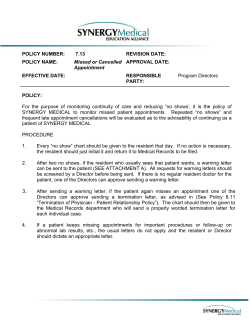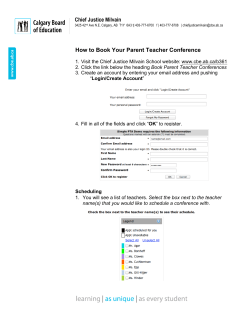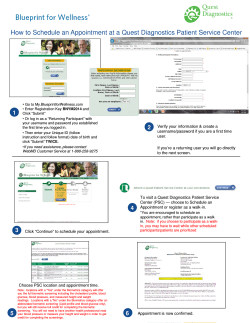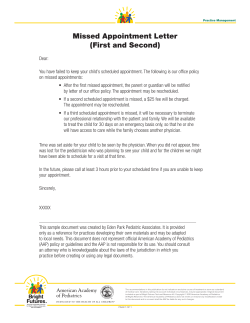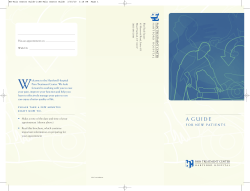
Switching on and promoting Patient Record Access: A
Switching on and promoting Patient Record Access: A guide for Record Access facilitators and champions by Richard Ince, Project Manager, myRecord This publication was produced as part of myRecord, a Health Foundation-funded project that seeks to promote online GP Patient Record Access for patients in the London Borough of Lewisham. For more information contact Richard Ince at: richard.ince@nhs.net 1 Contents 1 About this document and Introduction 3 2 Winning hearts and minds 4 3 Frequently asked questions 10 4 Recruiting patients 14 2 1 About this document If you are a Record Access facilitator or champion, this guide will help you promote and switch on Patient Record Access within primary care. A major part of your task involves winning hearts and minds. GPs and practice managers are often resistant to allocating time to discuss this service, for a number of reasons. This guide sets out the key barriers you may face, and presents arguments that will help you overcome them and communicate the many benefits that this exciting initiative offers to practices and patients alike. Introduction Patient Record Access enables patients to access key information about their condition and treatment to help them manage their own health and healthcare. It results in a change in the patient/GP relationship, where patients are no longer the passive recipient of care, but an equal partner in the healthcare process. Patients can securely view their GP records online through an accessible system with a range of features. For example, they can: make appointments and order repeat prescriptions get test results review past consultations*, including diagnoses, advice and treatment* view letters between their GP and other health professionals* check their record and flag up any inaccuracies confirm dates, to help them fill in forms for insurance or benefits print off information to bring to a medical appointment access their up-to-date health records even when on holiday find out more about their condition, through links to trusted resources, including information sheets, websites and support groups. *Please note, some practices choose to hide free text from within the consultation and letters to and from the GP. This reduces the small chance of a patient viewing something within the record that may concern or upset them. Under The Data Protection Act 1998 their practice may refuse access to all or part of your health records1 Patient Record Access has been running in around 80 practices for over five years, and early findings indicate a range of benefits to patients and practices2. In 2011 the government announced that all patients will have online access to their medical records by 20153. This guide draws on hands-on experience of rolling out Patient Record Access in Lewisham since March 2010, and on feedback from a sample of switched-on practices, to see what worked and what didn’t. 1 see ‘what are the legal requirements for sharing data?’ in FAQs Preliminary results from a practice who have offered this facility to patients for five years 3 Department of Health, The Power of Information: Putting all of us in control of the Health and Care Information we need (London: DoH, 2012). 2 3 2 Winning hearts and minds Many practices are understandably sceptical about the notion of sharing patient records with patients. For many years, clinicians have held patients’ information and used their discretion when and how to share it with their patients. But times are changing, and in the new health service there is an emphasis on shared care, with patients playing a more equal relationship to clinicians not only in decision making and choice, but in taking responsibility for managing their own conditions. A person’s ability to access their own records is a fundamental step towards playing a more active role in their healthcare and health. Among clinicians, common reasons for resistance to Patient Record Access include time pressure, misconceptions about the approach and fear of change. To counteract these fears, you need to adopt a systematic approach to overcoming these barriers and help practices and their patients take advantage of this exciting new opportunity for patient empowerment. 4 Tips: Overcoming barriers Listen to each individual’s concerns to identify where the fear is coming from, then suggest solutions. Be positive and non-threatening. Instead of telling people what to do, present them with new ideas and unexpected answers. Share success stories showing how other practices and their patients have enjoyed using Patient Record Access. This is extremely powerful in helping overcome concerns. Before we look in more detail at strategies, the box below summarises the key benefits of Patient Record Access to patients and practices. You need to keep these points clearly in your mind so that you can share your positivity with others. The key benefits of Patient Record Access Taking part enables practices to join their peers at the cutting edge of best practice in healthcare. The system reduces administrative tasks and the need for appointments for usually straight forward matters, such as checking for test results or to see whether a referral has been made – making life simpler for practices and patients alike. The openness and transparency of health management increases trust and leads to improved GP–patient relationships4, with higher-quality consultations, and better joint working. Patient Record Access improves patient satisfaction.5 The system enables patients to inform the practice about inaccuracies. Demographic information is the most common, but practices have also discovered incorrectly recorded diagnoses. Patients will be able to share essential accurate information relating to their health with clinicians, OOH (out-of-hours) or outpatient departments, improving continuity of care; patients will also be able to share their record with health professionals abroad – for example, when they go on holiday. The system encourages patient behaviour that promotes better health and empowers patients to care for themselves more effectively.6 As well as presenting the patient’s information, the record acts as a portal to an increasingly wide range of features that help them understand the NHS system better and manage their own condition more effectively. Practices can offer Patient Record Access to whomever they choose, and can opt for a measured, gradual launch if they prefer. Some practices prefer to start slow – for example, by initially offering the scheme to particular groups, such as people with diabetes or patients taking methotrexate. 4 myRecord Patient Survey, 2011/2012 myRecord Patient Survey, 2011/2012 6 myRecord Patient Survey, 2011/2012 5 5 We now look at eight ‘golden rules’ that will help you win the hearts and minds of GPs and practice staff in persuading them to adopt Patient Record Access. Eight golden rules There are eight golden rules that you need to follow when influencing GP practice staff to adopt Patient Record Access: 1. Gain influential support. 2. Be dogged and persistent. 3. Log every detail of every conversation, and use this information to inform your approach. 4. Do your research and preparation before practice meetings. 5. Present the scheme clearly, emphasising its flexibility. 6. Be a good listener. 7. Use good news stories to overcome concerns. 8. Follow up and don’t give up! We now look at each of these in turn. Rule 1: Gain influential support Before approaching practices to promote Patient Record Access, it is worth gaining influential support at a higher level. Having the seal of approval at commissioning level will add weight and authority to your goal. Make contact with managers of clinical commissioning groups (CCGs) and draw on their contacts and expertise to influence other relevant stakeholders. Push for slots at local neighbourhood meetings and joint forums to present to many stakeholders. Once you successfully develop widespread support, this will open doors when approaching practices directly. Rule 2: Be dogged and persistent. It is important to understand the constraints on a practice manager’s or GP’s time. Persistence pays, and you may need to contact the practice manager on numerous occasions before you can arrange a meeting. The first response may be negative, as practice managers often say they are too busy. This may not simply be a brush off – practice managers do have many competing priorities. So, you need to be flexible with dates and times – offer to work around them. If you feel that you aren’t getting anywhere on your initial call, tell them you will call back in a month to discuss a suitable time. Make a note to call them back, and when you do, mention your promise to call back. This will show that you are organised and, more importantly, that you won’t go away! If you want to quickly and successfully implement Patient Record Access, you need to secure an appointment to present Patient Record Access at a practice meeting where decision makers are likely to be present. Some practice managers will insist on meeting you beforehand, to decide whether you may present. Although this additional meeting will delay the process, a one-to-one meeting with the practice manager is a good opportunity to build a rapport and demonstrate the system, which you may not have time to do during a ten-minute slot at a practice meeting. If this initial meeting goes well, the practice manager may also 6 become an advocate for Patient Record Access during the subsequent meeting. But where possible, always ask for decision makers to be present. Rule 3: Log every detail of every conversation, and use it to inform your approach. You need to make the most of all the information you gather during this phase. Here are some ideas to help: Create a contact log for all practices so you can see how often and when you have contacted the practice, along with any other key conversations you have had and with whom. For example, a practice manager may say ‘We’ve got a lot on this month, but call back next month and we should be able to see you.’ Logging who said this, and noting in your calendar when to call them back, will improve your chances of setting up a meeting. Email the practice. Make your first contact with the practice via an email to the practice manager and lead GP or partner. Explain why you would like to speak at their practice meeting, outlining the benefits of Patient Record Access. Invite them to come back to you with a possible date, and say that if you haven’t heard from them within a certain period of time, you will call them back. This may prompt them to suggest a date. Telephone the practice manager shortly after the deadline that you gave for a response in your initial email. Practice managers can be hard to contact, as they are often in meetings or out of the office, so you may need to call several times before you reach them. Avoid calling at busy times. For most practices, this means avoiding mornings – especially on Mondays. Some project managers work flexible hours, and many are away from the practice on Friday afternoons. When speaking to the practice manager, be as brief and direct as possible. Be assumptive in your approach – for example, by saying: ‘I’m following up an email I sent you on [date] with regards to discussing Patient Record Access. I’m calling you, as promised, to set up a convenient time to speak at the next available practice meeting. My presentation will take no longer than 10 minutes and it will be a good opportunity to outline the benefits that this free service offers to patients and practices. Which of your forthcoming practice meetings would be best for me to come and speak to you and your team?’ Rule 4: Do your research and preparation before practice meetings. Make sure you tailor your approach to each individual practice. Before you present to a practice, look at their website or any literature they have produced. Do they already offer online appointment booking? If so, Patient Record Access is only one small step further. Find out other details, including the patient list size and how many GPs there are. Is there a patient participation group (PPG) that you could work with to trial the system? When you meet the practice, refer to any information that you have gleaned in this way. It will show them that you have done your homework, and that you have a genuine interest in their practice, and understanding and helping them meet their specific needs and challenges. It is also a good idea to adapt your materials to each individual practice. For example, bring in copies of the enrolment form, amended to show the name of the practice. Rule 5: Present Patient Record Access clearly, emphasising its flexibility. When you meet the practice team, explain the system clearly and succinctly, emphasising the benefits to the practice. To recap, these include: staying at the cutting edge of best practice in healthcare reducing administrative tasks and appointments 7 improving the quality of consultations and facilitating better joint working improving patient satisfaction with their healthcare. Emphasise the flexibility within the system. For example: Move from online appointments to Patient Record Access If the practice already offers online appointment booking, emphasise how easy it is to take the one further small step of Patient Record Access. If the practice does not yet do this, set out the benefits. Run a staged roll out Some practices worry that introducing Patient Record Access to all their patients will increase their workload. One solution is to trial the system with just a handful of patients. Recruit interested patients (for example, by speaking at a meeting of the patient participation group, if the practice has one) and then set up a three-month trial. Once the trial is successful, the practice can roll it out in stages to specific cohorts such as diabetic patients, or patients who have already signed up for booking appointments online. This manageable approach often wins over practices that are reluctant to proceed, as it ensures there is little disruption to normal day-to-day practice activities. Tailor data visibility to practices’ needs. Most practices will not have the time to check individual records before allowing patients access. If the data in a patient’s record is entirely visible, there is a small risk of the patient seeing third-party or harmful data. Some practices feel that the benefits of an open record outweigh the small risk of this happening. However, others prefer to ‘hide’ historic data, showing only data added to the record after the practice launches the service. This enables clinicians to be more conscious of how they write, and allows the practice to put in place a process for dealing with this type of data. Even if historic data is hidden, read-coded7 conditions within past consultations remain visible, and the patient will still benefit from the useful links to further condition specific information. Rule 7: Be a good listener. From the time of your first point of contact, you need to listen carefully to any challenges, needs and concerns that your contacts raise. Try to see things from their perspective – if you can show how Patient Record Access offers genuine solutions to their problems, your argument will be more persuasive. After your presentation, invite questions from the group. Make sure you really listen to each individual’s concerns to help you understand where their fear is coming from. Then work collaboratively to suggest solutions. Prepare yourself as far as you can by studying the frequently asked questions (Section 3). If you encounter new questions, add them to this list after the meeting, to help yourself prepare for the next meeting. Rule 7: Use people’s stories to overcome concerns. Use people’s stories and quotations to illustrate the benefits of Patient Record Access. Explain patient-reported benefits in your answers (for example, feeling more in control of their condition, saving time, and not having to bother reception for test results), and use direct quotes and statistics in your presentation and discussions. 7 Read codes are the standard clinical terminology system used in General Practice in the United Kingdom. It supports detailed clinical encoding of multiple patient phenomena including: occupation; social circumstances; ethnicity and religion; clinical signs, symptoms and observations; laboratory tests and results; diagnoses; diagnostic, therapeutic or surgical procedures performed; and a variety of administrative items 8 Endorsement from colleagues in the field is another powerful tool. Find out whether any other local practices are offering Patient Record Access. If so, speak to the practice managers to ask whether you could provide their contact details to other practice managers or GPs with queries about how it has been for them. Otherwise, use quotations, statistics and case studies from around the country, and beyond, to demonstrate the benefits of this service. Rule 8: Follow up and don’t give up! Close the meeting by asking if you have managed to answer everyone’s questions. If you have not, make a note of any unanswered questions and agree to follow these up. If the practice is still undecided about whether to adopt Patient Record Access, arrange to call the practice manager at an agreed time – usually a week or two later – and put a reminder in your diary. If you are offering to support the practice with the switch-on process, it may help to speed up their decision by telling them you have availability to help them in the next month, for instance. It is often just as hard to gain a decision from a practice about Patient Record Access as it was to make contact in the first place. Do not take this as a knockback. Persist in contacting the practice manager for feedback. With their competing priorities, it may take 10 emails and 10 phone calls during the course of a year or more, but persistence does pay off. Even if they do not want to adopt Patient Record Access just now, it may be something they want to explore further down the line. 9 3 Frequently asked questions This section sets out a number of questions that you may be asked during the course of your work. Study the answers carefully and add your own notes as you develop further knowledge. What will it cost us to set up Patient Record Access? Nothing, Patient Record Access is currently free for the practice and patient Won’t the system mean more work for reception staff? If the practice already offers prescription or appointment online booking, there is little extra work to do. The extra work is in: obtaining photo ID, if the practice chooses to do this giving patients an information leaflet and form to sign and return recording the patient’s Record Access status as a read code answering occasional queries. Will we receive more telephone calls because patients want information about what they have read in the record? Experience in UK and US has not found this to be the case. Our research shows that people want, on the whole, to save their time and that of surgery staff. A number of studies have been conducted showing Patient Record Access to be time neutral8. One study, soon to be published, has shown for every 100 patients that access their record at least twice a year, 90 GP, 55 Nurse, 18 Healthcare assistant appointments and 211 phone calls were saved9. Do patients request more appointments because they want information about what they have read in the record? Similarly, there is no evidence for this. Some patients ask for more appts, but this is balanced out by more who need fewer appts. Will patients need longer appointments because they want information about what they have read in the record? At the time of writing (June 2012), more than 50 practices in England were offering Patient Record Access. The feedback received so far confirms this is not the case. On the contrary, some say that having read their record in advance, patients come prepared with more relevant questions.10 What are the security issues? Patient Record Access has the same level security as online banking. And like internet banking, there is a two-stage log-in process that only the patient will know, unless they decide to share their record with a carer or relative. Registering for Patient Record Access does not change anything in the way their information is stored, apart from the fact that they now have access. What are the legal requirements for sharing data? The Data Protection Act 1998 and Access to Medical Reports Act 1988 state that a patient (including ‘Fraser competent’11 children), or anyone authorised by the patient, are entitled to 8 Claudia Pagliari, Tim Shand and Brian Fisher, “Embedding Online Patient Record Access in UK Primary Care: A Survey of Stakeholder Experience,” Journal of the Royal Society of Medicine Short Reports, 3:5 (May 2012): 34. 9 Richard Fitton and Amir Hannan, Preliminary results from a currently unpublished study, 2012. 10 myRecord Patient Survey, 2011/2012 11 Fraser Competent is a term used to describe a child under 16 who is considered to be of sufficient age and understanding to be competent to receive contraceptive advice without parental knowledge or consent. 10 access their records, including reports supplied by a medical practitioner for employment purposes or insurance purposes. The two key exceptions for access to information are: where it may cause serious harm12 to the physical or mental health or condition of the patient, or any other person where it may relate to, or be provided by, a third person who had not consented to the disclosure – in the words of the Act: (a) provided by the data subject in the expectation that it would not be disclosed to the person making the request; (b) obtained as a result of any examination or investigation to which the data subject consented in the expectation that the information would not be so disclosed; or (c) which the data subject has expressly indicated should not be so disclosed13. The General Medical Council summarises the situation by saying: You do not have to supply a patient with information that identifies another person as the source of that information, unless that other person consents or it is reasonable in the circumstances to supply the information without their consent. Can patients view their child’s record? Parents, or those who have parental responsibility for children who are deemed not ‘Fraser competent’, are entitled to access the children’s medical records where it is in the child’s best interests. Most practices allow parents to access their child’s records up until they are 12 years old. Should you wish to access your child’s records beyond their twelfth birthday you need to discuss this with your practice. How can we prevent the patient from seeing third-party information? Third-party information can occasionally be seen in diagnoses, however, it is very unlikely but the risk can be substantially reduced by a practice excluding from a patient’s view, free text and letters from before a date of their choosing Could the system open us up to litigation? Some practices worry that Patient Record Access could enable patients to see clinicians’ mistakes and lead to increased litigation. In the US, where millions of people have access to their records, this does not appear to be the case. During the past 20 years some US states have allowed access at different rates, and litigation rates have not increased following liberalisation. What if information has been misfiled in the record? Although rare, it is not unknown for a practice to have misfiled a letter, making its contents visible to the wrong patient. Practices have to be extremely careful when filing and scanning. However, it is better for the error to be identified than for the information to be mislaid potentially compromising patient safety. 12 : There is no definition of 'serious harm'. The harm could be to the patient or to the doctor, but does not refer to poorly chosen words that might upset a patient. 13 UK Government, The Data Protection Subject Access Modification (Health) Order, 2000 (UK Parliament: London), 7: 5 (3). 11 Practices can choose to minimise this risk by hiding free text and letters from view, up to a certain date. Most choose to reveal data from the point when they launch the service. What if a patient is distressed by what they read? It is true that patients are sometimes distressed by what they read – but there is strong evidence that they prefer to see data held about them than not14. Psychiatric patients are the most likely to get upset15, but this is absolutely not a reason for withholding information from patients with mental health problems. What if patients interpret test results incorrectly? Patients can only see test results after the GP has seen them and filed them in the record. Results are complicated to understand, but patients can read the brief messages that practices write before they file the tests into the record. This is an opportunity for practices to save time by sharing brief notes with patients about re-testing, such as ‘Normal, but repeat in three months’ or ‘Abnormal, but usual for you – repeat in one year’s time’. What if there are inaccuracies in the record? Research shows that 10% of information in records is inaccurate – mostly demographic details. It’s very important that these inaccuracies are corrected, and often the patient is the only person who knows that it is inaccurate. Record sharing presents a great opportunity to correct these errors. Who developed the system? The system was by Patient Access to Electronic Record Systems Ltd (PAERS) (www.paers.net) – an independent for-profit company founded by three UK doctors. PAERS is currently working with EMIS, but its Patient Record Access system operates with any system provider. InPracticeSystems (the other big provider in the UK) are expected to merge some functions with EMIS in the coming year or so, making Patient Record Access available to more than 80% of the UK. The system is still in development, drawing on constant feedback from clinicians and patients. Can patients alter the record? No. This is a read-only facility. However, patients can print off details – for example, to take to a hospital appointment. If the patient spots something that they think needs changing, they need to contact the practice. Will we have to write the record differently? The record is a technical and medico-legal document whose prime function is to communicate between professionals. It is important that it is not ‘dumbed-down’ for a nonspecialist audience. However, the system has inbuilt tools to help with this. By linking technical terms to patient information in the PAERS system, there is little need for extra clarity. Nevertheless where it is possible to make the record clearer, this would benefit anyone who reads it, including clinical staff. For instance, why not use ‘stroke’ instead of ‘CVA’? Many acronyms are unclear to others, so it is best to abandon them if possible. All patients are read-coded for having access. Patient Record Access shows as a clinically significant condition, which is visible to the clinician when they open the patient’s notes What about security? 14 Molly Baldry, Carol Cheal, Brian Fisher, Myra Gillett, Val Huet, “Giving patients their own records in general practice: experience of patients and staff,” British Medical Journal, (Clin Res Ed) Mar 86, 1;292(6520):596-8 15 Molly Baldry, “Giving patients their own records in general practice: experience of patients and staff,” Mar 86. 12 Patient Record Access has the same level security as online banking, with a PIN and passwords to control the viewing. Nothing changes with the way the patient’s medical information is stored. Their information will remain under the control of the practice. The patient is responsible for keeping their log-in details safe. When they log off, or if there is a power failure, their patient information will automatically clear from their computer system so that it does not accidentally remain visible to others. Will my data be sold on to private health companies? No. The Data Protection Act (1988) states that personal data can only be used with the individual’s explicit permission. What if patients don’t want to register for the system? If any patient does not want to register, they can still use all the practices’ services exactly as before. It is important to emphasise to them that their decision not to register will not affect their treatment or their relationship with the practice in any way. 13 4 Recruiting patients If practices want Patient Record Access to make a real difference to the way they operate, they need to get plenty of patients on board. That means being proactive in their approach to promoting the scheme and recruiting patients. Simply displaying a poster in reception will have very little impact. Effective uptake can be managed in three key ways: GP and nurse referral This is by far the most effective way of recruiting a patient and encouraging them to use the system. Reception referral When patients ask to be registered for online appointments, the receptionist can ask if they also want access to their online medical records. Where possible, reception should process a patient’s request for access while the patient is in the practice. Evidence shows there is a very high fall-out rate if a patient simply leaves with the forms rather than signing up there and then. Patient awareness Awareness can be raised through various media, including: – posters and leaflets – the practice website, using the ‘alerts’ and ‘news’ functionality to inform internetsavvy patients about the service and how to sign up – the practice newsletter – targeted emails and texts – these can direct patients to your website for instructions on how to register. Patient Record Access has been adopted all three. shown to be most successful in practices that have 14
© Copyright 2025


